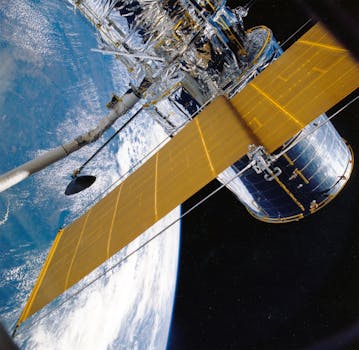
The Rise of Mega-Constellations: Latest Updates in Satellite Telecommunications
The Rise of Mega-Constellations is a significant development in the field of satellite telecommunications, with multiple companies launching thousands of satellites into orbit to provide global internet coverage. This new era of space technology is expected to revolutionize the way we communicate, with faster and more reliable internet connections available to people all around the world.
Mega-constellations are a new type of satellite system that involves launching a large number of small satellites into low Earth orbit. These satellites work together to provide a network of internet connectivity that can be accessed from anywhere on the planet. The idea behind mega-constellations is to provide a global internet network that is faster, more reliable, and more widely available than traditional satellite internet systems.
History of Mega-Constellations
The concept of mega-constellations has been around for several decades, but it wasn’t until recently that the technology became available to make it a reality. In the 1990s, a company called Teledesic launched a project to create a network of 840 satellites in low Earth orbit. However, the project was ultimately cancelled due to financial and technical difficulties.
In recent years, several companies have launched their own mega-constellation projects, including SpaceX, OneWeb, and Amazon’s Kuiper Systems. These companies have made significant progress in developing the technology and launching the first satellites into orbit. SpaceX, for example, has launched over 1,000 satellites as part of its Starlink constellation, with plans to launch thousands more in the coming years.
Benefits of Mega-Constellations
Mega-constellations have several benefits that make them an attractive option for satellite telecommunications. One of the main advantages is that they can provide global internet coverage, including to remote and underserved areas where traditional internet infrastructure is not available. This can help to bridge the digital divide and provide people with access to information and opportunities that they might not have had otherwise.
Mega-constellations can also provide faster and more reliable internet connections than traditional satellite internet systems. Because the satellites are in low Earth orbit, the signal has to travel a shorter distance, which reduces latency and increases speeds. This makes mega-constellations a good option for applications that require high-speed, low-latency connections, such as online gaming and video streaming.
Challenges and Controversies
Despite the benefits of mega-constellations, there are also several challenges and controversies surrounding their development and deployment. One of the main concerns is the potential for space debris, as the launch of thousands of satellites into orbit increases the risk of collisions and the creation of new debris. This can pose a hazard to other satellites and spacecraft, and can also contribute to the growing problem of space pollution.
Another concern is the potential for mega-constellations to interfere with astronomical observations, as the satellites can reflect sunlight and create a bright, diffuse glow in the sky. This can make it difficult for astronomers to observe faint objects, such as distant galaxies and stars, and can also interfere with the operation of sensitive astronomical instruments.
In addition to these technical challenges, there are also regulatory and governance issues surrounding the development and deployment of mega-constellations. There is currently a lack of clear international regulations and guidelines for the launch and operation of large satellite constellations, which can create uncertainty and confusion for companies and governments involved in the industry.
Conclusion
The rise of mega-constellations is a significant development in the field of satellite telecommunications, with the potential to revolutionize the way we communicate and access information. While there are several benefits to mega-constellations, including global internet coverage and faster, more reliable connections, there are also challenges and controversies surrounding their development and deployment. As the industry continues to evolve and grow, it will be important to address these challenges and ensure that the benefits of mega-constellations are realized while minimizing their negative impacts.
